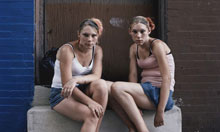This is a reposting of an article originally written by Sean O'Hagan for the Guardian. It is one of the most thoughtful and thought-provoking articles we have ever read. Our sincere appreciation to Mr. O'Hagan for his work and we hope by helping the dissemination of this work, the conversation is carried to wider circles, resulting in deeper and more meaningful conversations around this topic.
 Detail from Jeffrey Stockbridge's photograph of twins Tic Tac and Tootsie Photograph: National Portrait Gallery/PA
Detail from Jeffrey Stockbridge's photograph of twins Tic Tac and Tootsie Photograph: National Portrait Gallery/PA
 A photograph by David Chancellor of a 14-year-old American girl hunting in South Africa. Photograph: National Portrait Gallery/PA
A photograph by David Chancellor of a 14-year-old American girl hunting in South Africa. Photograph: National Portrait Gallery/PA
Lamprou's Portrait of My British Wife – on the shortlist for this year's Taylor Wessing photographic portrait prize – is a private moment made public. But when does art become voyeurism?
Photographers have taken explicit photographs since the invention of the form. It is still a surprise, though, to see Panayiotis Lamprou's image, Portrait of My British Wife, on the shortlist of this year's Taylor Wessing photographic portrait prize. It is, as the Guardian's arts correspondent, Mark Brown, put it (perhaps understating the case somewhat), "arresting because of its intimacy". It begs the vexed question, when does art become voyeurism or, indeed, pornography?
Lamprou photographed his wife sitting outside their summerhouse on the Aegean island of Schinousa. She has just finished eating an omelette and the dirty pan sits on table at her elbow. She is staring at the camera with a gaze that is difficult to read, wearing a short dress – or long T-shirt – and nothing underneath. Her legs are apart and her vagina is visible beneath the skirt. There is something both coy and provocative about the portrait, which, according to the photographer, was not originally intended for public display. (What changed his – and her – mind?) It will be interesting to see how the National Portrait Gallerydisplays the image when they exhibit it in a show of 60 of the submitted portraits in November.
 Detail from Jeffrey Stockbridge's photograph of twins Tic Tac and Tootsie Photograph: National Portrait Gallery/PA
Detail from Jeffrey Stockbridge's photograph of twins Tic Tac and Tootsie Photograph: National Portrait Gallery/PA
Undoubtedly many visitors to the gallery will find the image shocking, even offensive. Ironically, its tone of languor and intimacy sets it apart from the other three shortlisted portraits, all of which are provocative in different ways. Indeed, both Jeffrey Stockbridge's portrait of Tic Tac and Tootsie, twin sisters who have turned to prostitution on the streets of Philadelphia to fund their drug addictions, and Abbie Trayley-Smith's portrait of a young girl at a charity for obese children, could be considered more voyeuristic and exploitative.
Lamprou's portrait, though, cannot use the defence of social documentary or reportage. It is a private, intimate moment made public and, however consensual the contract between photographer and subject – and husband and wife - much of its arresting power lies in this uneasy dynamic. Do we, as viewers of what was originally an intensely private exchange, become voyeurs?
Lamprou's intimately explicit portrait is a very different kind of photograph than, say, the formally driven Teutonic female nudes of Helmet Newton, the hardcore imagery of Robert Mapplethorpe or the garish art-porn of Araki. Neither does it fit into the fashion-porn genre indulged in by the likes of Terry Richardson. Again, it is the intimacy of the setting – and the fracturing of that intimacy – that sets it apart and may even, for some viewers, make it even more problematic.
In both its explicitness and its blurring of the boundary between the private and the public, Lamprou's portrait calls to mind the taboo-breaking work of the young American photographer, Leigh Ledare. His book, Pretend You're Actually Alive, is a visual and written portrait of his mother, an erstwhile exotic dancer, who is both a narcissist and an exhibitionist. Over the years, he has photographed her in various explicit poses, both alone and with a succession of younger lovers, and the titles alone - Mom Spread With Lamp (2000) – give some indication of the content.
When Nan Goldin included Ledare's work in her selection for theRencontres d'Arles Festival, last year, it caused considerable debate among visitors, many of whom found it either offensive or disturbing. (Ledare, for the record, is a charming, well-balanced individual, and the book does work, in an albeit disturbing way, as a fractured chronicle of a thankfully singular strain family dysfunction.) It does beg the – now quaintly old-fashioned – question, are some things better left to the imagination than the camera? Or, more pertinently, the gallery wall?
Interestingly, too, it is nearly always women who are the object of the camera's gaze in these provocative photographs. (Mapplethorpe, a gay man, and Richardson, a self-confessed exhibitionist, both turned the camera on themselves, but they are the exceptions.) Would, one wonders, a full-frontal photograph of a relaxed, sun-dappled Lamprou taken by his wife be as arresting or provocative?
 A photograph by David Chancellor of a 14-year-old American girl hunting in South Africa. Photograph: National Portrait Gallery/PA
A photograph by David Chancellor of a 14-year-old American girl hunting in South Africa. Photograph: National Portrait Gallery/PA
What strikes me most about Lamprou's portrait – apart, of course, from its explicitness – is its apparent casualness. It has none of the heightened formal power of David Chancellor's portrait of a 14-year-old girl astride her horse with a dead impala. Instead, it looks, at first glance, like a holiday snap – but that, too, is part of its odd, and confusing, power. The dirty pan, the cluttered table, and the blurred chair in the foreground are all familiar signifiers of that certain feeling of relaxed torpor that descends on us when we settle in to a holiday. It's just that the eye is drawn elsewhere; we are given licence to look, to linger, to transgress the boundary between the accepted and the forbidden – at a cost, perhaps, to all of us, the photographer, the subject and the viewer … and to our ever-shrinking imaginations.











No comments:
Post a Comment